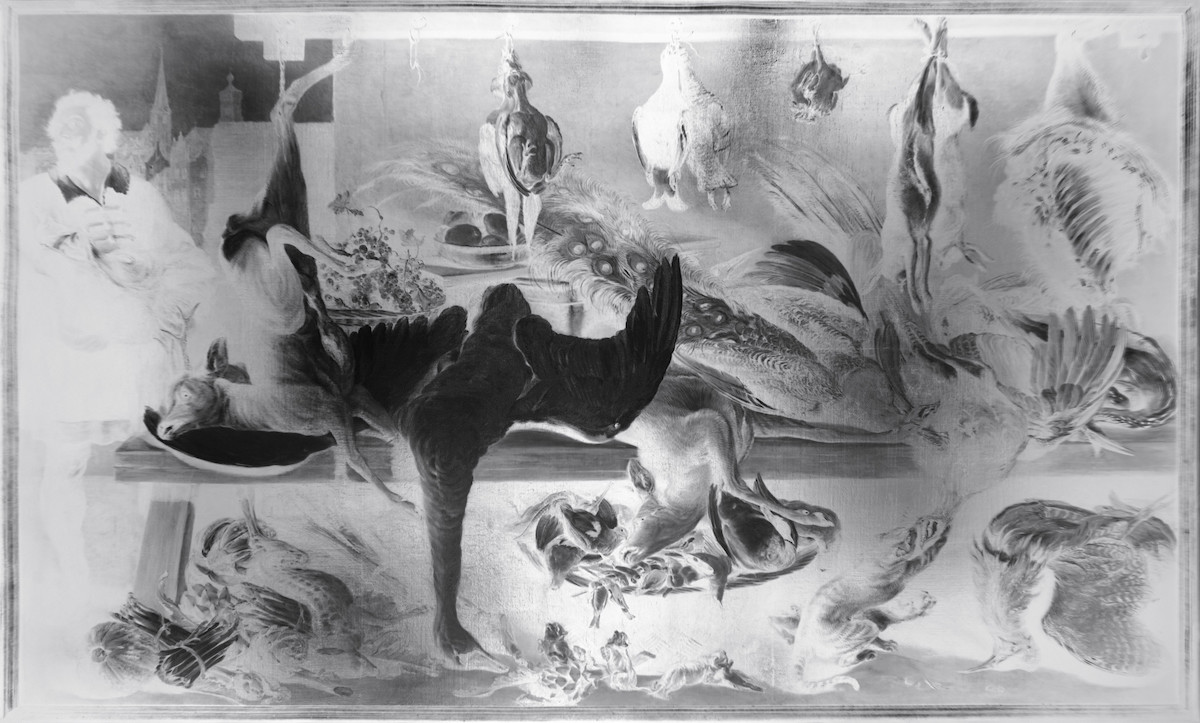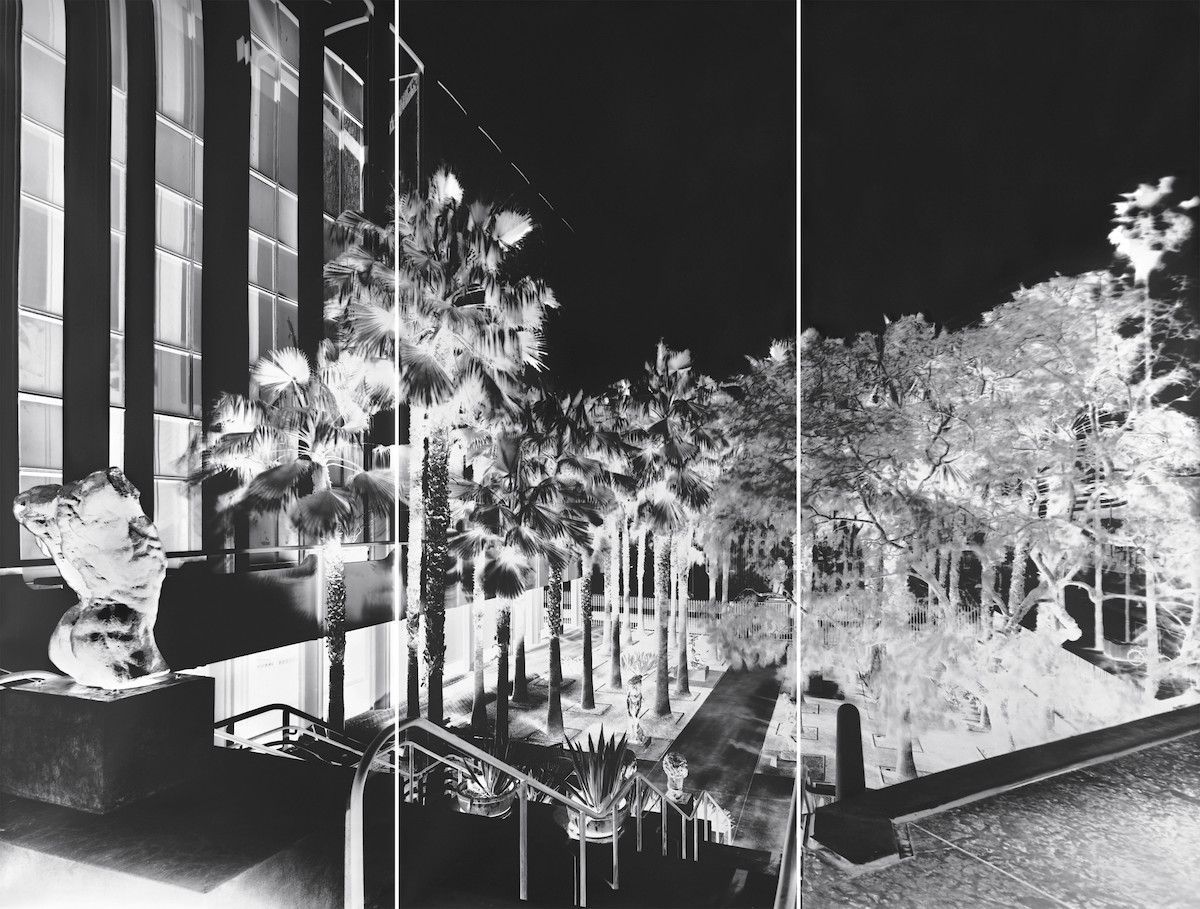One of the most uncanny things about the photographs in Vera Lutter’s exhibition Museum in the Camera, is the fact that many of the galleries depicted, as well as the buildings themselves are no longer there. Lutter shot on site at the Los Angeles County Museum of Art (LACMA) from February 2017 – January 2019, before the recent widespread demolition meant to make way for the new museum structure.
Using both stationary room-sized and portable smaller-scaled pinhole cameras, Lutter created images of both interior and exterior spaces at LACMA, as well as individual works of art. A pinhole camera is a camera without a lens. Light passes through a small hole that functions as an aperture projecting the object or scene in front of the “hole” onto the opposite wall, photographic paper or film. Pinhole cameras usually require long exposure times that results in motion blur as well as the absence of any objects that move continuously in front of the lens. The image created is also a backwards and upside down negative.

Vera Lutter, Art of the Pacific, II: September 21, 2017–January 5, 2018, 2017–18, unique gelatin silver prints, commissioned by the Los Angeles County Museum of Art through an artist residency supported by Sotheby’s, © Vera Lutter, digital image courtesy of the artist
Before gravitating to pinhole cameras in the early 1990s, Lutter turned her New York loft into a camera obscura to project large inverted images onto mural sized sheets of photographic paper to create unique large-scale negatives. She later constructed room-sized cameras she could use on location. Working with a crew at LACMA over two years, Lutter was able to fabricate not just one, but four room-sized cameras that she used to capture aspects of the museum, documenting exhibitions, gardens and the various buildings on LACMA’s campus. She also built smaller pinhole cameras to make individual photographs of specific objects of art and paintings. To create the oversized three panel image European Old Masters: December 7, 2018 – January 9, 2019 (2018-19) Lutter hid the camera behind a specially constructed wall and positioned the vantage point, the gallery lights and even the paintings to perfectly recede in space. The resulting photograph is an eerie and ghost-like image of the gallery in which these old master paintings hung. As a black and white negative, the walls are dark and the is ceiling white with black spots where the lights were positioned. The frames surrounding the artworks glow against the dark walls and in relation to the now lightly rendered paintings. The reflective corridor is devoid of people due to the month long exposure.

Vera Lutter, Art of the Pacific, II: September 21, 2017–January 5, 2018, 2017–18, unique gelatin silver prints, commissioned by the Los Angeles County Museum of Art through an artist residency supported by Sotheby’s, © Vera Lutter, digital image courtesy of the artist
Art of the Pacific, II: September 21, 2017 – January 5, 2018 (2017-18) is another three panel photograph (97 1/8 x 168 inches) where Lutter positioned objects and artifacts for the camera. Using objects from LACMA’s Pacific Islands collection, Lutter composed the photograph based on aesthetics, rather than factual relationships stating, “I was allowed to pick all my favorite pieces…. I brought all these characters together that aren’t from the same tribe, and aren’t from the same island, and might not really speak the same language, but I wanted them all to talk to one another.” In the resulting photograph, the three-dimensional objects appear flat, their tonalities a surreal group of tones due to the fact that the image is a negative. The arrangement of objects were similarly finessed by Lutter from inside the camera to maximize the compositional balance within the image.

Installation photograph, Vera Lutter: Museum in the Camera, Los Angeles County Museum of Art, 2020, art © Vera Lutter, photo © Museum Associates/LACMA
Included in the exhibition are pinhole photographs of individual artworks carefully shot on custom made “copy-cameras.” There are pinhole cameras arranged to face easels onto which Lutter placed specific paintings. Though recognizable as paintings, Lutter’s photographs highlight different aspects of the originals as again they are presented as reversed black and white negative images.
When Lutter first visited LACMA to contemplate the project, she became enamored by the area known as Rodin’s Garden. Not only was it beautiful, but it represented Los Angeles, with its billowing palm trees and traffic just beyond the fence. The plaza was both quasi-urban and a cultural landmark simultaneously. Her image, Rodin Garden, I: February 22, 2017, (2017) exemplifies this experience. Though recognizable, the quality of light and blurriness of the treetops takes one beyond reality into a dream-like environment. It is curious that Lutter includes two versions of this image, one is high contrast, while the other is much darker (over-exposed) with a more muted range of tones.

Installation photograph, Vera Lutter: Museum in the Camera, Los Angeles County Museum of Art, 2020, art © Vera Lutter, photo © Museum Associates/LACMA
Lutter’s images call certain photographic truths into question. While they were made with a camera, what was placed in front of the aperture (pinhole) changed due to the long exposures (some took several months). These images are single shots that were created not in fractions of a second, but over time and this durational aspect gives the finished photographs an uncanny quality. Although “real” they appear surreal because LACMA no longer has many of the courtyards or galleries Lutter documented and most of the art is in storage. Wandering through her exhibition, one cannot help but reflect on the demolished architecture and memories of the museum. While the works on view in Museum in the Camera serve as a reminder of what LACMA was, more importantly they are intriguing images and new works of art that re-present what is gone in surprising and unusual ways.
Vera Lutter
Museum in the Camera
Los Angeles County Museum of Art
April 1 – September 12, 2021


